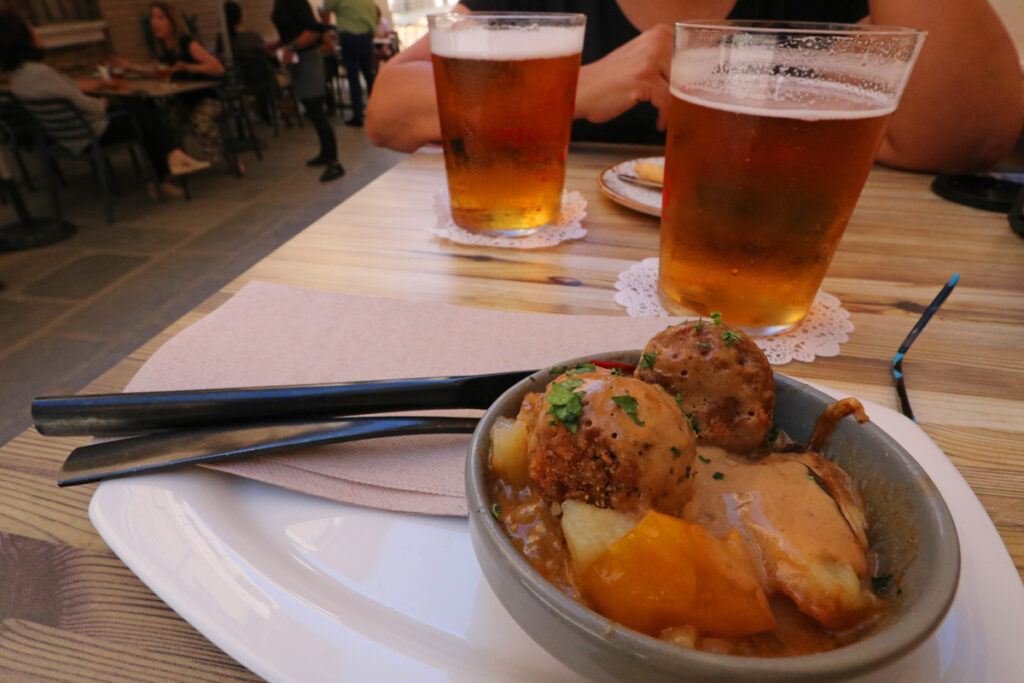Avoiding tourist trap restaurants in Spain
It’s happened to us a bunch of times – you’ve had a long day of travel and you’re tired and hungry. You just want to eat something. But that’s when you’re most susceptible to falling for a ¨tourist trap restaurant¨.
It doesn’t just happen in Spain, it happens everywhere. But there are a few tell tale signs in Spain that should tip you off that a restaurant is a tourist trap. I cover that here.
Restaurants that are busy outside of traditional hours
It’s 7 pm and you see a restaurant that’s busy with diners.
That’s a tourist trap restaurant.
The Spanish have different meal hours than many other nationalities. Breakfast tends to be early and light (pastry or a “tostada” and a coffee) and people may have a very early “breakfast” and other later breakfast if they crave something. Lunch tends to be the biggest meal of the day and Spaniards usually have this meal around 2pm. Lunchtime “menu del dia” (menu of the day) are the best value meals with a fixed price that usually includes at least 3 courses and a drink (in my experience usually between 10-15 Euros). Dinner starts late, starting at 8pm at the earliest and are usually lighter than what most Spanish eat at lunch (although that can depend on the individual).
So if you see a restaurant filled with diners outside of those hours, then you can count on it being a restaurant catering to tourists (where you’ll get mediocre quality and higher prices).
But there are other more obvious tip-offs that a restaurant is a tourist trap…

There’s a host inviting you into the restaurant
You’ve seen it: you’re walking down the street past a restaurant and there’s a pretty girl or a buff guy smiling at you with a menu in their hand. We see it all the time walking down the street in the center of Granada (the city where we live).
Keep on walking.
In a typical Spanish restaurant you’ll sometimes have a hard time just catching the waiters eye, never mind getting a smile or a wink. And you better be ready to order when he comes around because if you waste his time it might be 15 minutes before you see him again.
So a host might make you feel good about yourself (who doesn’t like a pretty girl smiling at them) but chances are you’re getting seduced into shitty and over-priced food…

Online Reviews and local suggestions (but…)
A lot of people rely on reviews from websites like Trip Advisor. I find that can be a hit or miss…but usually a miss depending on many factors.
Reviews are only as good as the people who leave them and if the people leaving those gushing reviews are Twenty-something year olds who’ve never eaten Spanish food, then you might end up in the typical tourist trap restaurant. I find that is especially true for highly rated restaurants in popular tourist cities.
About online reviews: Anthony Bourdain used to have a trick to find a good restaurant: “Go to a number of foodie websites with discussion boards. Let’s say you’re going to Valencia — just post on the Spain board that you recently returned from Valencia and had the best Paella in the universe, and give the name of a place, and all these annoying foodies will bombard you with angry replies about how the place is bulls***, and give you a better place to go.” (his actual example was about rendang in Malaysia but I’m just trying to give you a Spain-related example of a tactic you could use).
If visiting a city, I will always ask a local for a recommendation. Maybe an Airbnb host or a hotel concierge. But there’s a caveat here…
We used to travel full-time and asking a local was something we always did. But we noticed in the beginning that all the suggestions we received were for overpriced tourist restaurants. Locals sometimes have a certain idea of what you as a foreigner want. So I’ve learned to be precise “we want a good, affordable place where locals go. We don’t want to spend a lot of money or eat tourist food. Do you have any recommendations?”. That will get you better results.

Location of a restaurant
We all know (or should know) that restaurants around tourist attractions or popular squares and streets are going to appeal to tourists. Yet we always seem to fall for them.
On our first visit to Venice we sat down at a café on Piazza San Marco (one of the ones where there’s music being played by musicians) and ended up with a bill of 40 Euros for 2 coffees. There was a surcharge for the music. That was back in 2008 and is still the stupidest food-related decision I’ve ever made.
While it may not be as egregious as that, you’ll always pay more for a place in a popular location. It applies to Spain as well. And chances are that the food will be inauthentic tourist slop.
As I say, there are many places to avoid in the center of Granada. But step away, maybe walk 5 to 10 minutes away, and you’ll come across a local place where food is authentic and prices geared towards locals.
Sometimes you want to have a coffee or a meal at a scenic spot. There’s nothing wrong with that if you knowingly choose that. But with that comes the knowledge that you’ll be paying for that location in one way or another. A perfect example are rooftop restaurants. There are some nice ones in Granada but all are overpriced, filled with tourists, and you’ll be greeted by a pretty girl who speaks perfect English…
Which brings me to my next point…

English menus, English-speaking waiters
Any place that has English menus – including the ones with huge menus featuring glossy images of food you’ll never actually see on your plate – means that it’s a tourist trap restaurant. Especially if combined with staff that greets you in English. These restaurants should be totally avoided.
Many Spanish restaurants don’t have any menu. They may have a menu written in chalk on a board that’s barely legible. We have a place in our neighbourhood that has no menu at all – we show up for breakfast and the waiter comes up to us and asks us what we want. The first time we came there we had to ask “well, what do you have?”. Now we’re regulars.
The less menus on display, the less likely that it is a tourist trap restaurant.

All the other diners are foreigners
It’s pretty obvious but I’ll include this anyway: if you see that everyone eating in a restaurant is a foreigner (ie. no locals), then you are in a tourist trap restaurant. The thing is that many tourists get nervous – the whole foreign restaurant experience can be intimidating – and there’s a certain safety in going to the same places that other tourists go. But that’s a sure way of overpaying and eating mediocre food. The best experiences are often when you take risks when eating out.
Instead, go to restaurants where locals go. Just follow the noise: people laughing, shouting and the click-clanking of knives and forks are usually giveaways that a place is a popular local restaurant.

Other signs
There are other signs that a restaurant is a tourist trap. Does it serve everything under the sun, from hamburgers to pizza to paella? That’s an easy give away. Is the kitchen open all day? That’s unusual – most Spanish restaurants work quite specific hours and the kitchen will often be closed during different hours (usually between 5 pm and 8 pm, ie between lunch and diner). Is there a “Sangria special”? Sangria is a tourist drink, the local equivalent is a Tinto de Verano.
Finally, local restaurants often have napkins all over the floor. It’s a traditional thing in Spain and would in the past be a sign that you wanted another tapa. But to this day a restaurant with napkins all over the floor means that a place gets a lot of local traffic – and is a sure way of avoiding a tourist trap restaurant.
Related: Restaurant laws in Spain (and what you can’t be charged for!)

Related: The “Tipping Protocol” in Spain


Excellent article, very true indeed. We visited Granada this past weekend and got “trapped” in an exact place you describe: prime Granada Centro location, fancy menus in leather covers, English speaking waiters…the result: mediocre(tasteless flavorless) food at high prices. The only reason we ended up at this place was that the recommendations we got from our local host were all full(for a good reason!) so we got tired and hungry of checking places and just sit at one of the few ones that had open tables.
Great information, very useful !
I don’t think you re being very fair here
Just because it’s a restaurant that tourists frequent it doesn’t mean the food is crap…for those of us not keen on Spanish food filled with garlic it’s good to have another choice
And just because they speak English doesn’t mean it’s a tourist restaurant anyway
I’m not sure we’re talking about the same thing. There are non-Spanish restaurants that people will go to that are perfectly fine. We love Indian food for example and we’ll often have it once or twice a month. You won’t usually see Spanish people in there. But there’s a difference between that and “tourist trap” restaurants targeting – guess what? – tourists. Tourists coming here don’t always know better so they may fall for a “tourist trap” restaurant. And the food they’re served will often be generic and I’ll bet you anything they’ll be charged and arm and a leg for it. THAT is what I’m talking about.
It also depends on the context. Is the restaurant in Nerja? If so it can be quite understandable that the waiter speak a bit of English because of the heavy expat population. Is it in Granada? Well, if you have someone waving a menu at you here while speaking English, it is definitly a ´tourist trap´ restaurant.
By the way, it’s my second attempt to post a comment on your post. It looks like a sort of censure applies , doesn’t it? 🤣🤣🤣
It’s called “moderation” and it’s where comments go before being approved. Except when it’s a nasty or unhelpful comment (like yours) in which case it gets deleted.